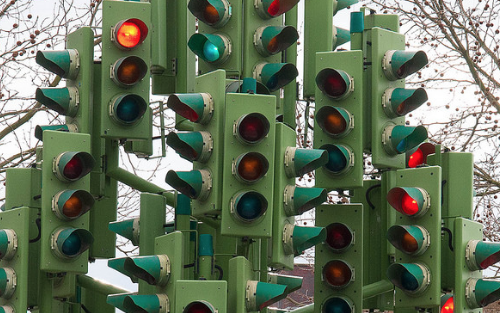Red light cameras work. The Washington Post runs the same old attack on them anyway.
Red light cameras work, but articles saying they don’t, based on more innuendo than fact, pop up in the press regularly. The latest example is from Washington Post “Tripping” blogger Frederick Kunkle.

This is a sculpture. There’s no penalty for running these red lights. Image by Daniel Guimberteau on Flickr.
DC uses cameras around the city to catch people running red lights. The machines photograph the license plates of cars that run red lights, and a few weeks later the car owner gets a ticket in the mail. The city has 48 cameras set up, and issues thousands of tickets each year.
Proponents argue that the cameras effectively combat dangerous driving, reducing collisions and making streets safer for everyone. Others, while they may broadly agree that there’s a need for better red light enforcement, voice concerns that range from whether or not the cameras work properly to people’s ability to fight tickets in court to the claim that DC is too dependent on revenue from camera citations.
In a column on Tripping that went up last week, Kunkle mentions that the total number of tickets from red light cameras is down in DC (another way of putting this: fewer people are speeding running red lights), and that a majority of drivers happen to support DC’s red light cameras. He also notes that almost all drivers agree that running a red light is a dangerous activity that needs to be curbed. Those two facts alone might be considered good news for many who want to see a government program prove to be popular and effective.
But as he continues, Kunkle spins these facts into negatives. The total number of tickets might be down, he says, but since DC’s fines are higher than in Maryland the total amount of revenue collected is higher— a clear money grab by the District. And even though there is a lot of support for the cameras, Kunkle uses the term “slim majority” to hint that red light cameras may be more controversial than they actually are.
This is creating a scandal where there isn’t one
Throughout the article, Kunkle quotes speculation from John Townsend of AAA Mid-Atlantic, including the thought that the city is playing “dirty pool” by having its yellow lights turn over extra quickly.
DC has not simply shortened its yellow light times, and a look at the big picture makes it clear that there’s no money grab happening here. Last year, DDOT changed the timing of hundreds of stop lights across the city, but that included every phase of the light, including pedestrian signals. That’s something DDOT needs to do as it works on the incredibly complex issue of creating traffic flow that gives everyone what they want.
Still, even with the lack of evidence, Kunkle fuels the thought that nefarious traffic engineers are out there shortening yellow lights so more people run reds.
Another claim from Townsend that Kunkle leans on is the notion that most red light tickets are somehow erroneously issued for drivers “who stopped beyond on [sic] the intersection threshold line or beyond the stop line but who never crossed the intersection”— as if stopping late and possibly blocking the crosswalk at the intersection are not serious problems in and of themselves.
The fact that different jurisdictions do not always have the same fines should not be a shock. But rule number one in bad traffic camera journalism, it seems, says that you cannot talk about fines unless you openly wonder whether or not the cameras are there for safety or for revenue. Send the message that cameras are there solely for revenue, and you can help ensure that people focus on simply removing the cameras rather than think about ways to improve safety at intersections.
Kunkle is gracious enough to suggest that city’s motivations could be about revenue and safety, but the “really makes you think” rhetorical device used across the column is clearly aimed at getting people ready to expect a scandal despite a lack of any evidence.
Traffic safety measures shouldn’t turn into us vs. them affairs
Its disheartening to see columnists like Kunkle twist neutral or positive facts into bad things. All it does is play into the narrative about a “war on cars” that tries to shut down any proposal or idea that even loosely appears to treat driving as an equal part of the transportation landscape rather than the primary and superior way to get around.
Worse, these kinds of arguments divert attention away from improving the city’s camera program for everyone, drivers included. Even red light camera proponents have ideas to improve them to help ensure they’re more effective and fair. For example, our own David Alpert has argued that raising DC’s camera fines is the wrong approach to traffic safety— instead, the solution is lower but more frequent citations. Casting red light cameras as evil from the get-go limits conversations about how to make them better.
Insinuations that cameras are about revenue rather than safety, or spinning neutral facts into bad news, do little to inform people about an issue that is important to just about everyone. Once a driver who is under the “threat” of a traffic ticket parks their car and has to cross the street to their final destination, they benefit from safe streets just as much as the next person. The Post should do better.
Correction: This post originally said fewer tickets means fewer people speeding. It meant to say fewer tickets means fewer people running red lights.
